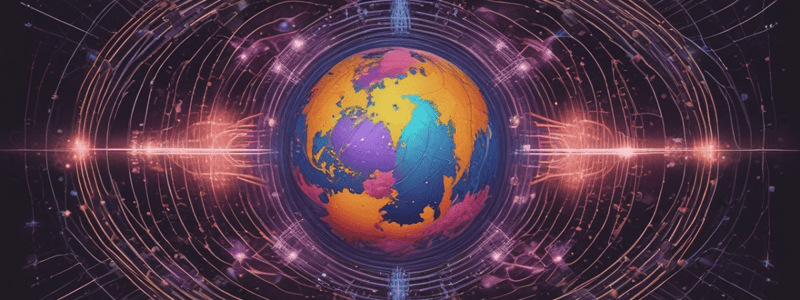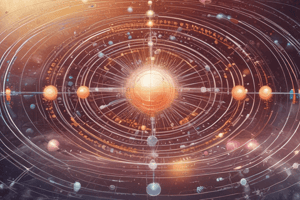Podcast
Questions and Answers
What is the charge of a positron?
What is the charge of a positron?
- -1
- +1 (correct)
- 0
- Undefined
What is produced during beta radiation?
What is produced during beta radiation?
- Only neutrinos
- Neither beta particles nor neutrinos
- Only beta particles
- Both beta particles and neutrinos (correct)
What is the purpose of the neutrino in beta decay?
What is the purpose of the neutrino in beta decay?
- To absorb energy
- To change the charge of the nucleus
- To conserve energy and momentum (correct)
- To emit light
What is the result of high-speed proton-proton collisions?
What is the result of high-speed proton-proton collisions?
What is the process called when a gamma photon creates a subatomic particle and its antiparticle?
What is the process called when a gamma photon creates a subatomic particle and its antiparticle?
What is the significance of the equation 0n 1 → 1p 1 + −1e 0 + 0ν 0?
What is the significance of the equation 0n 1 → 1p 1 + −1e 0 + 0ν 0?
What is a characteristic shared by antiparticles and their corresponding particles?
What is a characteristic shared by antiparticles and their corresponding particles?
What occurs during pair annihilation?
What occurs during pair annihilation?
Which force do leptons not experience?
Which force do leptons not experience?
What type of particles are electrons, positrons and neutrinos classified as?
What type of particles are electrons, positrons and neutrinos classified as?
Which particles are not fundamental?
Which particles are not fundamental?
Study Notes
Particle Charges and Production
- A positron carries a positive charge.
- Beta radiation involves the emission of a beta particle, which can be either an electron or a positron, along with a neutrino.
Beta Decay and Neutrinos
- The neutrino plays a crucial role in beta decay by conserving energy and momentum during the process.
High-Speed Proton-Proton Collisions
- High-speed collisions between protons can lead to the production of various particles, including mesons and baryons, through the release of energy.
Gamma Photon and Particle Creation
- The process in which a gamma photon creates a subatomic particle and its antiparticle is known as pair production.
Significance of the Beta Decay Equation
- The equation ( ^0n_1 \rightarrow ^1p_1 + ^{-1}e_0 + ^0\nu_0 ) represents neutron decay, highlighting the transformation of a neutron into a proton, electron, and neutrino, emphasizing conservation laws in particle physics.
Antiparticles
- Antiparticles share similar mass and spin with their corresponding particles but possess opposite charges.
Pair Annihilation
- During pair annihilation, a particle and its antiparticle collide and annihilate each other, converting their mass into energy, typically in the form of gamma photons.
Leptons and Forces
- Leptons do not experience the strong nuclear force; they only interact via the electromagnetic and weak nuclear forces and gravity.
Classification of Particles
- Electrons, positrons, and neutrinos are classified as leptons, which are fundamental particles not composed of smaller entities.
Non-Fundamental Particles
- Composite particles, like protons and neutrons, are not considered fundamental because they are made up of quarks.
Studying That Suits You
Use AI to generate personalized quizzes and flashcards to suit your learning preferences.
Description
Learn about neutrinos, subatomic particles produced in beta decay with very little mass and electrical neutrality. Neutrinos are emitted alongside beta particles during beta radiation, carrying momentum and energy to ensure conservation.




